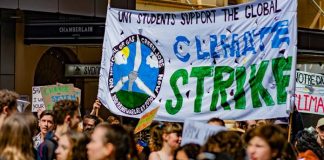A mass, student-led movement has emerged in Chile, fighting for free education.
In late September, 180,000 students and teachers marched on the streets in the latest mass demonstration. This followed a half-million strong demonstration of students and their families in mid-August in Santiago and a two-day general strike called by the Chilean Trade Union Congress (CUT) in which 600,000 people took part.
The global resistance to austerity no doubt inspired the “Chilean winter”, named in reference to the Arab Spring. Highschool and university students provided the spark, but the enthusiasm with which their demands have been taken up across Chile reveal a deeper discontent with an unequal system.
Detonators
The protests are a continuation of the two-month student strikes in 2006, when 1000 high schools and universities were occupied and 100 unions and other organisations joined them. These protests won limited reforms but weren’t enough to end the system of privatised education.
Many of the schools involved in 2006 are leading the current movement and many university students cut their political teeth in the earlier strikes.
The latest burst of student activity began in May. Since then, 700 schools have been occupied and there are daily demonstrations demanding an end to education for profit.
When police repression failed to quell protests in July, billionaire President Piñera sacked the minister for education, then replaced his successor. He announced a $4 billion education fund for poor families in an attempt to appeal to protesters.
But his crumbs were not enough. In late August 50 high school students stormed Chile’s Ministry of Education and occupied it for two hours before police removed them.
The students are acutely aware of the more fundamental roots of the problem. They know that superficial tweaks to the system won’t address the fact that tuition fees are astronomical, forcing students to take out loans that mean many don’t graduate because of the debt burden. As University of Chile Student Union president Camilla Vallejos said, “The people understand that the crisis in education is in fact a crisis of the model installed under the dictatorship. The protest is not against today’s government, but against the neo-liberal model.”
Neo-liberalism
Chile’s privatised education system is a product of the neo-liberal agenda pioneered in Chile after a violent US-backed coup in 1973 installed dictator Augusto Pinochet. The economic architects of Pinochet’s Chile were the free-market disciples of Milton Friedman. They privatised public assets like health and education, entrenching inequality.
A popular movement ousted Pinochet in 1990, but the centre-left government that succeeded him maintained the same free market policies. The legacy is a gutted public sector. Less than half of high school students attend public schools.
Chile now spends 4.4 per cent of its GDP on education, but the UN recommends at least 7 per cent for developed nations. A competitive voucher system pits schools against one another, polarising educational quality and depriving the already deprived, creating a system some critics have called “educational apartheid.”
During the two-day strike 1400 protesters were arrested. A 16-year-old boy, Manuel Gutiérrez, was shot and killed by police. In the face of repression students have generalised their demands and galvanised the opposition. They are now demanding a new constitution that guarantees quality education, re-nationalisation of the mines and a more progressive tax system.
Student slogans like “Educate, don’t profiteer” are getting a wide resonance in a society marked by deep inequality. Solidarity with other struggles for social justice amongst workers, environmentalists and indigenous people could help build popular support.
2011 began with struggles against the construction of an environmentally destructive dam, opposition to rising gas prices, and the fight against pay cuts for copper miners. The resistance can only spread and deepen by engagement with the workers, on whom Chilean capitalism depends.
The momentum is with the students, who have 80 per cent support, while Piñera’s popularity has plummeted to 26 per cent and the opposition, Concertacion, is at 16 per cent.
The tenacity of the student movement is particularly significant after decades of enforced silence and fear under the tyranny of Pinochet.
Now a new generation of activists has come of age. Their confidence and courage has the potential to make this a long, hot winter.
By Lachlan Marshall





